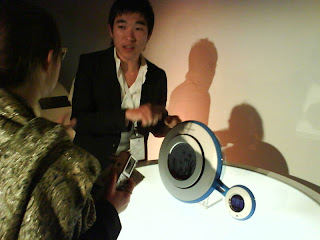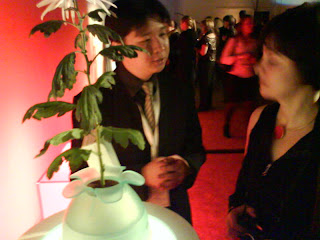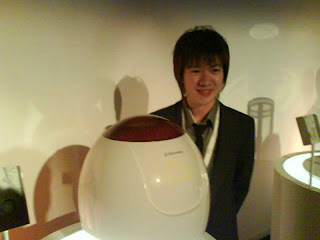 Videos from Design Lab 2007 in Paris are on the Design Lab website. There is footage from the awards ceremony (including footage of Dan Fielding, Domestic God, the International Forum on Design and the Environment, Electrolux and sustainability, the finalists and their arrival in Paris and the design of the award itself. You'll find them all here.
Videos from Design Lab 2007 in Paris are on the Design Lab website. There is footage from the awards ceremony (including footage of Dan Fielding, Domestic God, the International Forum on Design and the Environment, Electrolux and sustainability, the finalists and their arrival in Paris and the design of the award itself. You'll find them all here.
Thursday, November 29, 2007
Design Lab webcasts now online
 Videos from Design Lab 2007 in Paris are on the Design Lab website. There is footage from the awards ceremony (including footage of Dan Fielding, Domestic God, the International Forum on Design and the Environment, Electrolux and sustainability, the finalists and their arrival in Paris and the design of the award itself. You'll find them all here.
Videos from Design Lab 2007 in Paris are on the Design Lab website. There is footage from the awards ceremony (including footage of Dan Fielding, Domestic God, the International Forum on Design and the Environment, Electrolux and sustainability, the finalists and their arrival in Paris and the design of the award itself. You'll find them all here.
Wednesday, November 28, 2007
Light blogging ahead
Was not able to get a bluetooth keyboard for the phone, so it'll be short posts this evening and maybe a few photos, if the lighting is good enough. We'll get the names of the winners to you as quickly as possible and you will be able to find the full press release on electrolux.com.
Now it's off to the Palais de Tokio for the big event.
Tuesday, November 27, 2007
Be aware and make the better choice
Increasing one's awareness and the value of each individual making better decisions were two of the main themes of the presentations by the Design Lab jurors Tuesday evening at the first International Forum on Design and the Environment.
French designer Matali Crasset opened the proceedings with a presentation of objects and spaces designed to challenge expectations. He example of Splight City illustrated how a home, like the leaf of a plant, has a nerve structure through which energy flows.
Jason Bradbury, the UK gadget afficionado extraordinaire, was filled with gee-whiz enthusiasm for various gadgets, like a water-powered battery ("This is Star Trek") and a wind-powered flashlight, which he brought along and passed around the audience. He also showed of a few of his home-made contraptions, like a working hoverboard (Think "Back to the Future with Michael J Fox) and a bluetooth glove phone that inspired Motorola to send him a cool USD20,000 for a copy. His favorite gadget, though, is a powered wheel called "Easyglider." It's like a unicycle wheel and can be hooked up to pull various contraptions.
Bradbury also pointed out the importance of timing, citing the sad case of Sir Clive Sinclair who lost his fortune in the 1980s betting on the Sinclair C5, a battery-powered one-seater tricycle that could reach a maximum speed of 15 mph. It's the kind of alternative to a moped that might find an interested market today.
Celine Cousteau opened her presentation by praising Electrolux for being one of the companies that is looking to the future in a green way, adding "Green is the only future we have." She brought us some passionate advocacy for indigenous peoples of the Amazon based on first-hand knowledge. In one encounter when she was a little girl, a woman served her something from the cooking pot. "It was a simple gesture of sharing, but she shared everything she had," Cousteau commented.
Many of the anecdotes in her presentation illustrated the point that people from other culture can have a lot to teach you if you are paying attention, whether it's how to count fish in a lake, how to take pleasure out of simple things like jumping rope or how much children have to offer. "Don't underestimate kids," she emphasized. "Teach them that they are powerful and they will make powerful choices."
She concluded by making the point that each individual's actions have consequences. "Every action you take has a reaction somewhere. And if you can inspire yourself, you can inspire the person next to you."
Electrolux Global Design Head Henrik Otto finished up the day's presentations. He opened by saying that designers need to be very curious and passionate about what they do and they have to be curious about things that are not directly related to their work. He also said that designers have to make conscious choices about materials and technology and should choose materials that will make the product desirable from a recycling standpoint.
He cited bottled water as an example of something that is wasteful because it is being shipped all over the world and because as soon as a bottle is empty, it is thrown away. A water dispenser in the fridge solves the problem if you are near your fridge, but even bottled water could be more environmentally sound if the water companies offered refills.
After the presentations, the floor was opened up for questions. One key question, which came from a blogger via this blog, was whether the need to design with sustainability in mind was a plus or a minus for designers.
"I like constraints," answered Crasset. "When I have a constraint, I know where I'm starting."
Added Otto: "The smaller a challenge is for designers, the longer they will put off dealing with it."
Last chance to send in your questions to the panel!
If you can design a chair...

Learned that a chair is one of the most difficult things to design. In the photo, Jacques Treville, who runs the Stua boutique in the Village St Paul design area, holds a bar stool whose curved form is designed to make the bar still look good, even if all of the stools in a row in front of the bar are swiveled in different directions. Bartenders like stools with backs, you see, but the bar tends to look untidy unless the stools are all turned towards the bar. What else makes designing a chair so difficult? People come in all shapes and sizes and a chair has to be comfortable for all of them for an extended period.
This was part of a fantastic design tour with the students this morning through this 14th century neighborhood. The students seemed very engaged, if the number of questions they asked and the number of photographs they took is anything to go by. One student was even overheard asking some very specific questions about how to go about submitting a design to one of the companies they looked at. (Updated at 19.17)
Monday, November 26, 2007
Dan Fielding, "Domestic God," to host awards dinner
British entertainer Dan Fielding, also known as "The Domestic God," will host the Design Lab awards dinner on Wednesday. Fielding was recently the protagonist of the comic novel "Men in Aprons," which chronicled his trials and tribulations in work and in love on his way to becoming an expert on everything to do with household tasks. He introduces himself as the host of the dinner in this YouTube video.
Design Lab to offset carbons
As part of its overall effort to minimize the environmental impact of the Design Lab event, Electrolux has offset both travel and on-ground carbon emissions through The CarbonNeutral Company and its program called Methane Capture Projects.
This project captures methane from animal waste at three farms in Germany. Methane is 21 times more potent than CO2 as a greenhouse gas.
In the project, anaerobic digesters and combined Heat and Power plants have been installed at three farms. The methane produced is captured in the CHP plants and used to generate electricity and heat. The electricity is sold ito the national grid and the heat is used on the farms.
This project captures methane from animal waste at three farms in Germany. Methane is 21 times more potent than CO2 as a greenhouse gas.
In the project, anaerobic digesters and combined Heat and Power plants have been installed at three farms. The methane produced is captured in the CHP plants and used to generate electricity and heat. The electricity is sold ito the national grid and the heat is used on the farms.
Friday, November 23, 2007
Now we know what they're going to talk about
Well that was quick. The summaries arrived while I was writing the previous post. Looks like an interesting combination of abstract and practical, product-oriented presentations. Could be a good balance.
Matali Crasset on Environmental design: looking at the bigger picture
In general, people view items as autonomous objects. Matali’s hypothesis is that an object is an interconnected part of a whole is an essential theme of experimental design. This philosophy brings forth what goes on behind the scenes of our environment, to visualize what has become more and more invisible in our world today. Removing the layers of history and technology that sometimes create a distance and autonomy between things allows the observer to see the interconnections. Matali’s example of Splight City illustrates the visualization of these interconnections: how the home, as a whole, is a hierarchical structure that exists out of three dimensions. Just as the leaf of a plant, a house has a nerve structure in which energy flows. These nerves can transmit energy to the entire home’s structure, diffusing such things as light, heat, and images. It is a genuine system of objects that are in constant evolution.
Céline S Cousteau on Lessons from the Indigenous Tribes of the Amazon
From an indigenous reserve in Brazil, to remote northwestern Peru, the lessons I learned from the original inhabitants of the Amazon jungle transcend country and culture and unite us in a common future. Their health assaulted by the petroleum industry for over three decades, the Achuar are fighting for their very lives. Between illegal loggers, a government occupied with other concerns, and hepatitis in alarming numbers, the tribes of the Vale do Javari in remote Brazil are hanging on by a thread. The Shipibo of the Peruvian Amazon, the Andeans living near the glaciers, and the others, each have taught me something about the impact we have on this planet. Their future is also our future -- we are all connected to the same destiny.
Henrik Otto on Thinking outside the Box: How to work with sustainable design
The paradox of sustainable design is that as soon as we talk about the subject, people immediately start thinking of timeless, iconic designs that will last forever. This is not how I interpret the concept. To me, sustainable design is much more than that. Sustainable design is about awareness of options and consequences. It is about communication – the communication of values and attitudes. And more importantly, it is about getting designers, consumers and manufacturers around the world to make conscious choices in their daily lives. Looking to the future, and we may not have to look so far, we will no longer have a choice between sustainable or non-sustainable design.
Jason Bradbury on Green Gadget: Making 'Eco' Sellable
(Updated November 26) The iPhone may be innovative but is it green? How is the design of mass consumables utitlising sustainable materials and practices? Can a gadget be cool - and green? Is sustainability the new black? The Gadget Show's Jason Bradbury offers a overview of some of the designs and technologies that have shaped and will be shaping our eco future.
Matali Crasset on Environmental design: looking at the bigger picture
In general, people view items as autonomous objects. Matali’s hypothesis is that an object is an interconnected part of a whole is an essential theme of experimental design. This philosophy brings forth what goes on behind the scenes of our environment, to visualize what has become more and more invisible in our world today. Removing the layers of history and technology that sometimes create a distance and autonomy between things allows the observer to see the interconnections. Matali’s example of Splight City illustrates the visualization of these interconnections: how the home, as a whole, is a hierarchical structure that exists out of three dimensions. Just as the leaf of a plant, a house has a nerve structure in which energy flows. These nerves can transmit energy to the entire home’s structure, diffusing such things as light, heat, and images. It is a genuine system of objects that are in constant evolution.
Céline S Cousteau on Lessons from the Indigenous Tribes of the Amazon
From an indigenous reserve in Brazil, to remote northwestern Peru, the lessons I learned from the original inhabitants of the Amazon jungle transcend country and culture and unite us in a common future. Their health assaulted by the petroleum industry for over three decades, the Achuar are fighting for their very lives. Between illegal loggers, a government occupied with other concerns, and hepatitis in alarming numbers, the tribes of the Vale do Javari in remote Brazil are hanging on by a thread. The Shipibo of the Peruvian Amazon, the Andeans living near the glaciers, and the others, each have taught me something about the impact we have on this planet. Their future is also our future -- we are all connected to the same destiny.
Henrik Otto on Thinking outside the Box: How to work with sustainable design
The paradox of sustainable design is that as soon as we talk about the subject, people immediately start thinking of timeless, iconic designs that will last forever. This is not how I interpret the concept. To me, sustainable design is much more than that. Sustainable design is about awareness of options and consequences. It is about communication – the communication of values and attitudes. And more importantly, it is about getting designers, consumers and manufacturers around the world to make conscious choices in their daily lives. Looking to the future, and we may not have to look so far, we will no longer have a choice between sustainable or non-sustainable design.
Jason Bradbury on Green Gadget: Making 'Eco' Sellable
(Updated November 26) The iPhone may be innovative but is it green? How is the design of mass consumables utitlising sustainable materials and practices? Can a gadget be cool - and green? Is sustainability the new black? The Gadget Show's Jason Bradbury offers a overview of some of the designs and technologies that have shaped and will be shaping our eco future.
Labels:
Amazon,
Andean,
Andes,
Brazil,
consequences,
consumers,
design,
environment,
hacking,
manufacturers,
Peru,
philosophy,
technology
Panel to discuss environment and design issues
In connection with the Electrolux Design Lab 2007 competition, the first International Forum on the Environment and Design will take place in Paris on November 27 (15.30 – 17.00 CET). Presentations will be made by all four Design Lab judges:
- Award winning French Industrial designer Matali Crasset,
- The UK’s best known gadget and consumer technology presenter Jason Bradbury,
- International Environmental Activist Celine Cousteau and
- Henrik Otto, Head of Global Design for Electrolux.
They are all pretty accomplished individuals and each brings a perspective on sustainability and how it relates to their own specialties, so this should be interesting. We're going to get summaries of what they’re going to be speaking on a bit later today, so stay tuned.
Labels:
design,
disussion,
Electrolux,
environment,
event,
issues,
judges,
panel,
sustainability
Wednesday, November 21, 2007
Welcome to the Electrolux Design Lab 2007 blog!
This blog covers the fifth annual Electrolux Design Lab competition. Design Lab is an annual global design competition open to undergraduate and graduate industrial design students who are invited to present innovative ideas for household appliences of the future.
Hundreds of design students from around the world entered this year’s competition and were challenged to present their ideas on for eco-friendly and sustainable household appliances and solutions for 2020. Eight finalists have been invited to the final judging event and award ceremony in Paris, where the winner of Design Lab 2007 will be announced on November 28.
This blog will guide you through the event as it unfolds – you are invited to put questions to the members of the panel through the commentary field. You can expect more detailed information about the members of the panel shortly!
Watch this video for more information about the
Design Lab competition.
Hundreds of design students from around the world entered this year’s competition and were challenged to present their ideas on for eco-friendly and sustainable household appliances and solutions for 2020. Eight finalists have been invited to the final judging event and award ceremony in Paris, where the winner of Design Lab 2007 will be announced on November 28.
This blog will guide you through the event as it unfolds – you are invited to put questions to the members of the panel through the commentary field. You can expect more detailed information about the members of the panel shortly!
Watch this video for more information about the
Design Lab competition.
Labels:
design,
Design Lab,
Electrolux,
environment,
sustainability
Subscribe to:
Comments (Atom)





















